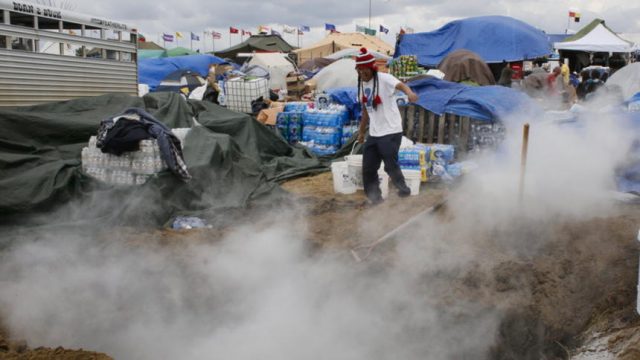#NoDAPL Environmentalists Trash the Land They’re Camping on While Feds Look the Other Way

The #NoDAPL protesters, supposedly a group of environmentalists out to defend the Earth from an evil pipeline company, are destroying the U.S. Army Corps of Engineers land they’re camping on. Even Standing Rock Chairman David Archambault expressed concerns about this in an interview with Vice last month.
“We’re no different than the oil company, if we’re fighting for water,” he said. “What’s going to happen when people leave? Who has to clean it up? Who has to refurbish it? It’s going to be us, the people who live here.”
North Dakota state officials have been concerned about this for a while. “We’ve seen pictures of trenches and the garbage thrown in there. So that’s protecting the land?” Rob Keller, a spokesman for Morton County, told Valerie Richardson at the Washington Times. “And then the snow came in, and I’m sure it’s just a muddy mess now, because that’s river-bottom water, which is silt. It will be a mess.”
Richardson reports that state Department of Health officials contacted the federal government about the problem months ago, but the feds aren’t responding:
Scott A. Radig, director of the state division of waste management, said he sent a letter with photos of protesters dumping and burning waste in pits to the U.S. Army Corps of Engineers, which has jurisdiction over the area, but that he has heard nothing back. That was in September.
“They did not respond to us,” said Mr. Radig. “It is federal land, but even though it’s federal land, they still have to follow state laws on state management practices.”
I guess this is more of what President Barack Obama wanted to let “play out.”
And while most of us would believe that the responsibility for treating the land appropriately lays with the people camping on it, the professional environmentalists are blaming the pipeline company – yes, the pipeline company – for the conditions of the camp. “Any environmental concerns sit at the feet of the pipeline decision-makers,” Perry Wheeler, a spokesman for Greenpeace, told Richardson.
Meanwhile, this article in the Weekly Standard is a truly eye-opening look at the conditions of the camp. An excerpt:
Coming down the rolling hills towards the river bank, the camp is bounded by the water on one side and fencing on the other three. Where Highway 1806 passes the camp, the protesters have erected a permanent guardhouse. Cones block off the road, forcing cars that are not allowed into the camp to turn around. At the gate, three burly Native-American men interrogate the occupants of each car. A sign posted behind them warns “no photography.” (Most of the journalists allowed to enter are required to have an escort at all times.)
Why do liberal collectivist utopias feel so statist? Waiting in line to enter the camp, I can’t help but wonder. At first glance, Sacred Stone combines the misery of a refugee camp with the guarded nature of a dictatorship. One of the men comes up to my window, suspicious of my reasons for coming. I try to appear as naïvely helpful and wonderingly curious as possible and in the end, he decides I can be allowed in.
As I start to walk around the camp, I can’t shake the feeling that for all of its claims of community—of solidarity with the Sioux Nation against the U.S. Army Corps of Engineers and corporate power—the underlying spirit of the camp is one of rules enforced by unspecified, yet unpleasant means.
This is a persistent theme, this gap between the reality of the #NoDAPL camps and the way they’re portrayed in most of the national media.
Read the whole thing.




